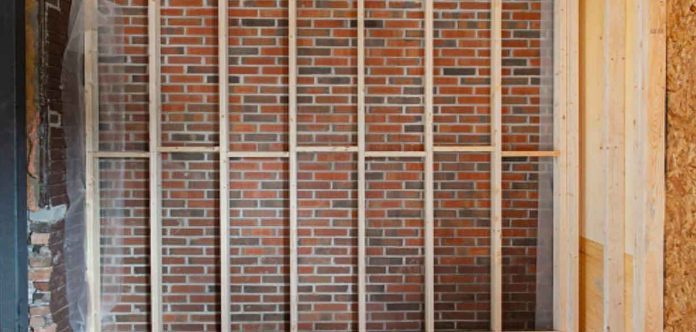A stud wall, also called a partition wall or an interior wall, is used to create an entirely new room. This could be a sitting room, an en-suite toilet, or a space where your kids can play.
You can also divide a home, office, or restaurant through these types of walls at a pretty reasonable cost. Furthermore, stud walls are easily removable if you want to remove the partition.
This article will explain the average cost of installing stud walls. How these costs go up or down, how you can reduce these costs, and how to hire a builder to complete the work are all discussed.
So, stick around until the end to answer all your questions about stud wall cost.
Comparing Quotes Could Save You Upto 33%:
How Much Does a Stud Partition Wall Cost?
Like the majority of people, you might choose to hire a handyperson to fix the problem. In that case, you need to think about labour and equipment prices.
A specialist typically charges you between £800 and £900 to build a standard stud wall, and the project will likely take two to three days. However, this is based on the assumption that no further fees or essential tasks need to be completed.
What elements can impact the price of a partition stud wall? The number of stud walls you require is just one of many variables that may affect the overall cost of stud walls.
For example, you can assume that you’ll need an additional simple interior wall, increasing the cost if you wish to split a massive space into two, three, or even four smaller tiny holes rather than just two.
Additionally, the cost of the job can also go up due to heater installation costs and separate electrical connections. Additionally, less obvious aspects like the position of your property may have an impact on the price.
You will likely pay extra the further a builder or carpenter travels to meet you. Furthermore, the size and position of your half walls also play an important role when calculating the final cost. Thus, larger rooms may increase the cost due to more wall material.
One can assume that this will also come out of their wallet if the place where you want your partition half walls placed is hard to access or if other problems might make the expert’s work more difficult.
Having that said, you might prefer something a bit more specialised, in which case you should consider the price per square metre for building walls, which should be between £2 and £5. However, the price per square foot is a little high.
| Task | Cost |
| A two-stud wall installation | £1600 – £1800 |
| Painting | £100- £350 |
| Stud Wall, lights, and radiator installation | £1100 – £1200 |
| Two-wall plastering | £150 – £300 |
| One Wall Plaster | £100 – £250 |
Comparing Quotes Could Save You Upto 33%:
The Stud Wall Installation Process
Required Equipment
- Spirit level
- Nail gun
- Hammer
- Hand saw
Required Materials
- Plasterboard (almost 13 mm thick)
- Nails
- Plumb line
- Studwork timber
- Wood glue (if needed)
- Metal studs
Comparing Quotes Could Save You Upto 33%:
Preparation
Carefully Mark the Place of the Wall
Your new walls comprise the ground plate, roof plate, upright studs, and lateral braces as their four primary components.
Choosing a location for your wall is the first step in installing it. Wherever you decide to anchor your stud wall, make sure that the fence is tight enough to drill or hammer through. This keeps you from accidentally hitting any wires or pipes inside the wall while installing.
Utilising a computerised pipe and wire detector, you have a lot of freedom in where you can install stud walls because they aren’t load-bearing wall structures.
Lastly, mark the place where you have to install the stud wall. It will help throughout the installation process.
Be Sure About the Building Rules
After deciding on a place and sizing your stud wall, you must confirm that the wall complies with current building codes and regulations. Firstly, check if your local building codes allow the installation of a stud wall. Some buildings even have a strict rule if somebody keeps their interior walls framed.
Contact your local building authority to ensure your designs fit construction rules. You should also confirm that adding an interior wall won’t affect the building’s fire resistance, lighting, or air circulation. You may start the installation if your interior wall satisfies these two inspections.
Comparing Quotes Could Save You Upto 33%:
Step 1: Building The Frame
-
Floorplate
It’s time to start taking some dimensions and cut your lumber to size once you have decided where your wall will go. You should deal with the floor plate in the beginning. To complete this, measure the wall from the start of the stud wall all the way to the end. Your floor plate must fit across two skirting or walls.
Next, slice one or two pieces of wood to size, checking that the wood is straight and matches the gap. Using only a nail gun or drill, fasten these pieces of wood to the ground at a distance of about 400 mm. Your interior wall will have this as its foundation.
-
Ceiling Plate
The ceiling plate part is tricky, so you should follow every step carefully. So, it’s time to repair the head or ceiling plate. On the walls or skirting boards, mark the location where you want your interior wall to be.
Connect a bit of string to the mark you made, and then follow the string up to the ceiling. Use a spirit level to ensure the line is correct and straight as you draw along this thread length.
To indicate the location of the top of your stud wall, add a thin line at the ceiling level as well. Before attaching, you might use a plumb line to be sure that your ceiling plate is exactly over your floor plate.
You can push a nail into the roof near the wall-to-ceiling joint. Next, using a pencil, draw a line connecting the two spots to indicate where the ceiling plate would go on the other ceiling, which you measured and marked.
You must locate the roof joists to which you will fasten your ceiling plate if you hammer the nails into a concrete ceiling containing concrete beams. To fill the line you’ve drawn, cut your bit of lumber to size and fix it to the roof.
-
Vertical Studs
Draw a clear line across your measurement along two walls between your floor plate and ceiling plate, then slice your wall studs to the size. To make sure the vertical studs lay straight, you may form a slot where your border panels are if needed using a tenon saw.
Once you’ve completed this, you must attach your stud plates to the walls to unite your floor and ceiling plates at either end. Beginning just above the skirting board, start drilling your stud plates into the wall at regular intervals.
Comparing Quotes Could Save You Upto 33%:
Step 2: Fill the Stud Frame by Installing Noggins
When the half wall is complete, you should measure and cut vertical studs now. To indicate where your wood studs will have to go, draw a line on your floor plate with a marker at set intervals. Try to space your intervals 400 to 600 mm apart.
This will strengthen your stud wall and simplify things for constructing plasterboard in the future. If you’re planning to add an entrance door to your partition wall, be careful with the door frame when putting in your vertical stud markings.
Ensure your vertical studs fit snugly and securely from your floor plate to the roof plate before cutting. The noggins, which are little strips of wood that will be placed across your vertical studs, need to be measured and cut now.
These should assist in reinforcing your vertical studs and avoiding sloppiness in the completed stud wall. Calculate the space among your vertical studs at the ceiling plate, then cut a sufficient number of noggins at this size to add between the vertical studs at set intervals.
Use nails to fasten them to the sides of your vertical studs. For additional durability, you may use wood glue in addition to screwing or nailing your studs to the stud wall. Try to position them so your plasterboard can be fastened to them to provide the plasterboard sheets with support where they meet the wall.
You can use a drill to drill some openings in vertical studs or the noggins whenever you need to create space for cabling or piping within the stud wall.
Step 3: Add Plasterboard and Insulate the Stud Wall
The basic structure of your stud wall is almost complete now, so it’s time to install plasterboard or drywall. The plasterboard should preferably be 12.5mm thick. Keep a helper who can help you lift because the plasterboard may be hefty.
Using a drill and nails, attach your plasterboard (cut to length) to the stud wall framework in a horizontal position if possible. After securing one side of the plasterboard, apply insulation to the opposite side of the wall before attaching the plasterboard to the opposite side.
Your walls are now prepared for decoration after you have fastened the plasterboard and added a layer of plaster over it. You may paint the new wall or apply your favourite wallpaper based on your preference.
In order to make the stud wall-covered area soundproof and increase energy efficiency, it is best to place sound insulation between the two pieces of plasterboard. Insulation sheets, insulation film, or plasterboard are the ideal types of insulation to use when making stud walls.
Comparing Quotes Could Save You Upto 33%:
Building Stud Wall Cost Factors:
Stud walls can be made in different sizes and at varying costs. Here are all the factors that affect the cost of a stud wall:
1. Room and Building Size
Additional stud walls or exterior walls come in handy in bigger spaces and buildings. However, purchasing timber and plasterboard in bulk will typically result in a better cost per linear foot for stud walls (better value for money but not cheap).
Modern homes in the UK require ceilings that are 2.4 m high, and producers offer plasterboard sheets in various sizes to save waste.
If the roofs in your home are higher than average, trimming the panels to fit will result in more wastage and more shavings that need to be disposed of, both of which are more expensive and might considerably add to the cost.
2. Architect or Engineer’s Preferences
The role of the stud wall determines the plasterboard’s thickness. A stud wall must have certain elements that can withstand fire for 30 minutes.
To accomplish this, architects frequently require plasterboard finishes and coatings of 12.5 mm or two layers of 9.5 mm plasterboard. Inner walls and roofs must also be fireproofed to safeguard the wood, structural steel, and plywood from flame.
Fibreglass or Rockwool are often the materials for sound and fireproofing since they must also be fireproof. The engineer or architect might also want to install a glass door, a gypsum plaster core, and heavy electrical lines into the office space.
3. Stud Partition Wall Thickness
The price of your divider stud wall will depend on the wall thickness and the wall materials you choose.
For instance, a metre of 50 x 100 x 2400 mm stud wood costs almost £5.03 at a DIY store, whereas a little smaller piece, 50 x 75 x 2400 mm, costs £3.75.
You have the option of having steel or wood studs. Stud size matters, and steel studs are much more costly. If you utilise 600mm studs, you’ll require an extra 400mm stud.
4. Stud Centre Distances
The stud centre distances also play a massive role in the overall cost of stud walls. For instance, a division in which studs are placed at a distance of 400mm will use more timber than a wall where the studs are placed at a distance of 600mm. The 400mm wall would be more sturdy but might be too heavy on the budget.
5. Location
Your location may significantly impact the cost of a stud dividing wall. You won’t pay a contractor as much if you stay in a convenient, central area instead of a far-off place.
Your location will influence the actual project costs since builders consider travel expenses when negotiating the price and overall cost with you.
6. Electrical and Radiator Fittings
The separate place would need electrical and radiator fittings to make it liveable. The quality of these fittings will also influence the total cost of the stud wall fitting.
7. Painting & Decorating
A plain stud wall is nothing more than a piece of wood at first glance, and it can damage the appearance of your home or office. Therefore, it is essential to put some paint or decoration on it to make it presentable. The cost of painting and decorating will also add to the project’s total cost.
Comparing Quotes Could Save You Upto 33%:
What is a Stud Wall?
Anyone unfamiliar with the phrase “stud wall” may find it weird because they are pretty different from concrete walls. But it’s the most basic of things. There is nothing more to it than a timber structure plasterboarded over and insulated.
Moreover, it isn’t a permanent wall; therefore, the framing costs are not that high for a single-story house.
The installation of curved interior walls is too costly; that’s why stud walls are a better alternative. They are pretty much the same as exterior walls.
It serves as a divider or splits a vast space into several smaller ones. You can also use the stud divider to hide ugly wires and pipes. When the wall is complete, no one can see the studs; at first glance, you wouldn’t be able to tell this one from a brick wall.
People use stud walls or interior walls for several reasons, some of which are the following:
- Most offices around the globe are home to stud walls. Due to their versatility and relatively inexpensive installation, partition wall systems are incredibly beneficial for commercial workplaces. Partition walls are easy to install in huge places for relatively little money. Tempered glass wall installation isn’t OK in some buildings, so stud wall remains the last option.
- Using sturdy metal solutions will often result in greater fireproofing, but timber house framing still has much to offer regarding fire safety. This is useful for kitchen stud wall dividers in apartments or houses. High-grade plasterboard that is fire resistant is also necessary for many structures.
- Offices use customised sound boards to muffle noise from meetings, music, and other irritations. So, stud walls have again become a must.
Ideal Stud Spacing for a Stud Wall
The stud spacing for a wall varies from wall to wall. On average, you should push a stud every 400mm to 600mm, depending on various factors.
Moreover, due to the size of the boards you want to use, you will have a better sense of the gap that will work best when you measure the size and cut your plasterboard panels.
Use additional noggins if the space between your studs causes any issues during the plasterboard installation. This will provide you with more fantastic assistance towards the borders of the boards.
The Main Parts of a Stud Partition Wall Frame
The primary structural components of the stud wall frame system make up a stud wall. However, there are several components to the framed structure.
Many people would refer to a wall as a “stud wall” since the studs play the most crucial role in ensuring the wall’s structural stability.
A floor plate is one of the other significant components of a stud wall frame. The component that goes along the floor is known as the floor plate. In addition to the studs, floor plates are a crucial component of the frame since they anchor it to the ground. They may also go by the name “soleplate.”
Ceiling plates and noggins are two more essential components of the new wall frame that hold it in place.
Comparing Quotes Could Save You Upto 33%:
Planning Permission and Building Control
-
Planning Permission
If your property is classified, you won’t have to ask for a building permit from the building inspector, even if the stud divider is an interior wall. You must ask for listed building approval for any substantial changes in this situation.
-
Building Regulations
You must adhere to the necessary building regulations while constructing an interior wall out of studs and plasterboard:
-
Load-Bearing Walls
A load-bearing wall is built to sustain the above foundation or other construction components of a project. The weight of a home is also supported by it since it is a structural component, coming from the roof and higher stories.
Load-bearing walls transmit loads to the foundation or other appropriate frame members. Load-bearing walls can support structural elements such as beams, slabs, and walls on floors above. If a wall is intended to support the vertical load and is situated right above the shaft, it is referred to as a load-bearing wall.
One of them is the weight of load-bearing walls. On each story, a load-bearing wall usually sits above the others.
-
Non-Load Bearing Wall
A wall is considered non-load-bearing if it just supports itself and does not assist the construction in standing. The curtain wall is another name for this design. A non-load-bearing wall can also not carry roof or floor loads above it. It does not comprise the system of the structural frame.
Their main job is to split the floor into sections, and they are often inner walls. They are also made lighter to lessen the building’s dead load. In reality, removing any non-load-bearing walls won’t put the building’s security at risk.
The joists and rafters come in handy to identify a non-load-bearing wall. Furthermore, the load-bearing wall’s cost is identical to the cost of interior walls.
They are not in charge of providing the property with gravity assistance. The best part about non-load-bearing walls is that they are economical.
Comparing Quotes Could Save You Upto 33%:
The Difference Between Load Bearing and Non-Load Bearing Walls
The whole load of the floor slabs or the ceiling structure comes upon the load-bearing walls. Walls that are not load-bearing support no load.
A load-bearing wall is necessary for holding flooring and ceilings. In order to divide off spaces like offices, a non-load-bearing wall is built. You can calculate the strength of a load-bearing wall by inspecting the studs. Metal rods, or studs, are inserted into a wall’s timber frame. Two or more studs go hand in hand with each other to make up a load-bearing wall.
Most of the time, stud walls are non-load-bearing constructions, particularly when aligned to overhead floorboards. Nevertheless, some stud walls are adapted to support lightweight or thin joists and are semi-load-bearing.
Furthermore, if you want to replace a load-bearing wall, you will have a hard time disassembling it.
-
Fire-Resistance and Safety
A stud wall used to build a new room must be designed safely to stop the fire from spreading and offer an exit. To keep the wood from flaming, experts often install a 12.5mm layer of plasterboard on either side of the wall. The plasterboard in this grade provides 30-minute fire prevention.
You must install an outside window that can be used as an exit route if the new stud wall creates a room where the only fire exit route is through the next room. The floor of the chamber must be at least 4.5 metres above outside ground level to serve as an exemption from the fire safety law.
-
Sound Insulation
If you have built a stud wall to separate a toilet or a room from any other space, you must install sound insulation to make the space soundproof and comply with the resistance to sound law. Moreover, insulated concrete forms can also come in handy for sound insulation.
-
Ventilation
Ventilation is an important part of the stud wall installation process that won’t raise the installation costs too much. If the stud wall’s separate area doesn’t contain enough ventilation, it might fail to comply with ventilation laws.
-
Thermal Insulation
The thermal insulation of a stud wall or a half-wall room must be adequate to comply with the conservation of fuel and power law. Most soundproofing materials can also be used for thermal insulation to cut costs. Their efficiency will be comparable to that of specialised thermal insulation materials.
-
Materials and Workmanship
Every material used in the building of interior walls should be top-quality to comply with material and workmanship laws. Furthermore, professional standards are also necessary to comply with this law. You should care less about the material costs and more about the final wall’s durability.
Summary
Stud partition walls have many more uses than you might imagine. They can be used in homes, offices, or apartments to split up large areas. The best part about stud walls is that their removal is easy. So, if you have extra space in your home or office, build stud walls and put that space to good use.
But, all of this is easier said than done. Building a stud wall is a very tricky process and requires the services of an expert who has been in the business for quite a long time. An inexperienced carpenter can mess up your whole project. Moreover, an inexperienced professional can also spike the material costs.
Therefore, if you are looking for experienced and trained professionals to hire, knock on the doors of Bark.com. They provide the most budget-friendly quotes for your stud wall needs. Furthermore, they also offer other services like roofing, repointing, landscaping, etc. So, you can enjoy an all-in-one platform for all your needs.
Comparing Quotes Could Save You Upto 33%:![]()
Disclaimer: This article contains sponsored marketing content. It is intended for promotional purposes and should not be considered as an endorsement or recommendation by our website. Readers are encouraged to conduct their own research and exercise their own judgment before making any decisions based on the information provided in this article.



































